Festive phone call takes church on the route to virtual services
 In December last year, Blaydon Communications got a phone call they were not expecting. A member of the PCC at St Bede’s Church in South Tyneside called and asked if they could urgently upgrade the church’s sound system in anticipation of the festive events that were to be held in the church. The team at Blaydon were a little surprised as their installation work had been a bit thin on the ground during lockdown and they had been focussing a lot of effort on their online presence and having virtual meetings. The chance to get out was gratefully received as they were totally ‘Zoomed out’ at that point!
In December last year, Blaydon Communications got a phone call they were not expecting. A member of the PCC at St Bede’s Church in South Tyneside called and asked if they could urgently upgrade the church’s sound system in anticipation of the festive events that were to be held in the church. The team at Blaydon were a little surprised as their installation work had been a bit thin on the ground during lockdown and they had been focussing a lot of effort on their online presence and having virtual meetings. The chance to get out was gratefully received as they were totally ‘Zoomed out’ at that point!
During their socially distanced meeting with the resident Father of the church, it was explained that their existing sound system was not providing an intelligible sound to the congregation. The system included a lot of loudspeakers dotted around the church, which resulted in a cacophony simply bouncing around in the cavernous ceiling space and not sounding very good at all.
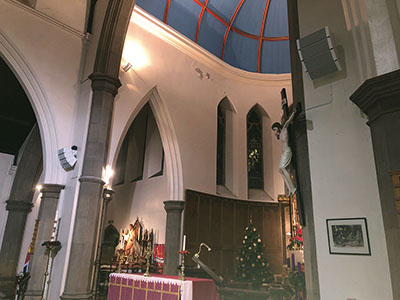 The significantly smaller congregation numbers did not help with the acoustics either: it is very surprising how a few extra people in a space can completely change the way it sounds. Having people in a reverberant space can really help absorb some of those horrible echoes that bounce around forever when the place is only a quarter full.
The significantly smaller congregation numbers did not help with the acoustics either: it is very surprising how a few extra people in a space can completely change the way it sounds. Having people in a reverberant space can really help absorb some of those horrible echoes that bounce around forever when the place is only a quarter full.
Blaydon Communications MD Paul Dougherty took up the story: “Our solution to the problem was a simple but effective one. We fitted a pair of loudspeakers that were capable of directing audio from the sanctuary to the back pew without bouncing unwanted sound all over the place. To do that you need a speaker that is fit for purpose, and in our experience a small compact array speaker system ticks all the boxes.
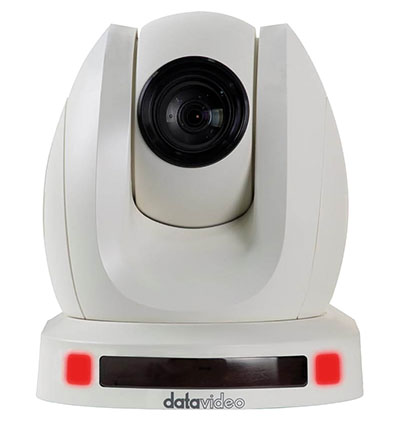 “The loudspeakers were mounted in line with each other, on walls in line with the front of the sanctuary and in front of any microphones, so we could get maximum volume with no feedback. Mounting loudspeakers in line gets all the sound moving in the same direction at the same time: that helps massively with intelligibility and minimises reflected sounds or echoes. For those of you that like the technical aspect of a system, feel free to get in touch or just Google TOA HX-5 to have a read about the speakers we used.”
“The loudspeakers were mounted in line with each other, on walls in line with the front of the sanctuary and in front of any microphones, so we could get maximum volume with no feedback. Mounting loudspeakers in line gets all the sound moving in the same direction at the same time: that helps massively with intelligibility and minimises reflected sounds or echoes. For those of you that like the technical aspect of a system, feel free to get in touch or just Google TOA HX-5 to have a read about the speakers we used.”
The team also had to upgrade the amplifier, so that sufficient power could be given to the new loudspeakers. The new amplifier had the added benefit of a few spare inputs, so the church took the opportunity to add a new media player to the system and can now broadcast music to the congregation via CD, USB, aux input, or Bluetooth. The existing microphones were fine, so the church were advised to save their money and keep what they had.
 Paul Dougherty continued: “The results were superb compared to the original system, but we did have a little complaint about it not being perfect towards the rear of the church. That was easily rectified with a quick visit from our engineers, who adjusted the dispersion angles of the loudspeakers and balanced the system perfectly from front to back. We even took advantage of a quiet spell and completed some intelligibility testing, with the results being more comparable with a carpeted room than an echoey old church!”
Paul Dougherty continued: “The results were superb compared to the original system, but we did have a little complaint about it not being perfect towards the rear of the church. That was easily rectified with a quick visit from our engineers, who adjusted the dispersion angles of the loudspeakers and balanced the system perfectly from front to back. We even took advantage of a quiet spell and completed some intelligibility testing, with the results being more comparable with a carpeted room than an echoey old church!”
December came and went without any issues and the limited congregation who could attend the church were happy with the system; but what about those who could not attend? Fortunately, the team at St Bede’s are always very keen to include everyone they can into their worship times, so they rang Blaydon Communications again to give them some ideas for a streaming service.
Streaming services can be very daunting for those that do not deal with it every day: just how do you get a picture from an old church onto the internet and into the homes and devices of the congregation? Is it some form of dark art or is it a simple process? The truth of the matter is that it can be both!
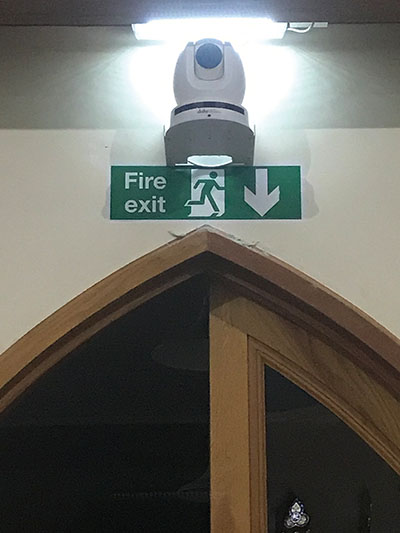 A lot of churches have very capable volunteers who are able to put on a TV show with 100 buttons for this and 100 controls for that, but they are in the minority and sometimes a simpler approach is needed. That was certainly the case for St Bede’s who had no one who could become a TV producer overnight; and they didn’t need that level of production anyway. Some conversations were had and everything was brought back to a sensible level.
A lot of churches have very capable volunteers who are able to put on a TV show with 100 buttons for this and 100 controls for that, but they are in the minority and sometimes a simpler approach is needed. That was certainly the case for St Bede’s who had no one who could become a TV producer overnight; and they didn’t need that level of production anyway. Some conversations were had and everything was brought back to a sensible level.
Discussion centred on what a person would see if they attended the church. Generally, they’d look at the sanctuary area as a whole, with focus given to the pulpit, lectern and altar at different times in the service. However, a general view of the sanctuary would actually suffice as long as it was accompanied by good audio. So that was the goal: put in a good camera that can view the entire sanctuary area and mix in an audio feed from the new sound system amplifier.
Paul continued: “Churches often struggle for funds, and while it’s never a good idea to overspend, it is always wise to have a level of future-proofing, too. When we looked at the price difference between a fixed broadcast-quality camera and a pan, tilt and zoom version, the cost was negligible, so the proposal was put forward with the moveable camera included. That small enhancement meant that the church could recall pre-sets of close-up shots of the lectern, pulpit and altar, or just stick with their general overview of the sanctuary area. We’re sure that as their confidence with the system increases, they will soon be panning back and forth like pros!”
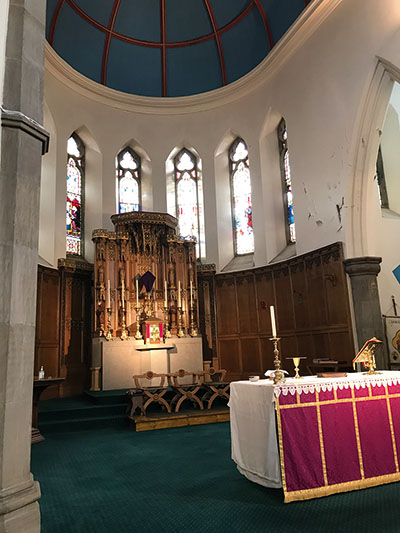 In addition to the functionality of the camera solution, they needed to consider the installation impact. Just how do you get power cables, video cables, audio cables and control cables to a camera installed in a listed building? The answer to that lay in technology called HDBaseT. Basically, with an HDBaseT solution, all of the needs of the camera can be met using one single CAT6 cable: the kind of cable used to connect a computer to a network so it’s easy to install and hideaway.
In addition to the functionality of the camera solution, they needed to consider the installation impact. Just how do you get power cables, video cables, audio cables and control cables to a camera installed in a listed building? The answer to that lay in technology called HDBaseT. Basically, with an HDBaseT solution, all of the needs of the camera can be met using one single CAT6 cable: the kind of cable used to connect a computer to a network so it’s easy to install and hideaway.
The final hurdle for the church was how they would stream everything to a streaming service on the internet? Some options were explained to them, and it was decided that YouTube would be the preferred streaming service. After all, everyone has access to it and it’s free, too! The cost of that one was certainly a major deciding factor.
Paul continued: “We helped the church setup a YouTube account and enabled their live stream and archive capabilities. We installed a device called a streaming encoder that takes the video signal, mixes it with an audio feed, encodes it to the correct format to match the available upload speed and required format for YouTube, then sends it out down the phone cables to everyone who wants to watch it. Sounds complicated? Well, that entire process is achieved by pressing a button marked ‘Start’: that’s it, it’s the only thing to do before getting on with the service. A push of a second button, aptly marked ‘Stop’, ends the transmission and everything sits and waits for the next service.”
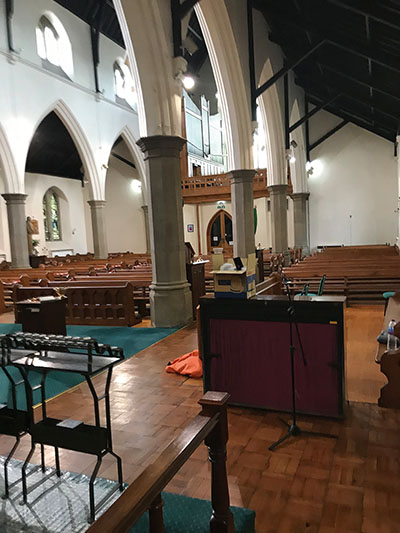 The church have been successfully streaming for a good few weeks now and, like many churches, will likely never stop providing the service even when lockdown is finally over.
The church have been successfully streaming for a good few weeks now and, like many churches, will likely never stop providing the service even when lockdown is finally over.
Paul Dougherty concluded: “It is often easy for churches and other venues to go way over the top on what they use to complete a streaming system, or even a sound system for that matter. We have seen some examples where even the most seasoned sound engineers and TV producers would sit and scratch their heads.
“The key to providing a good system for any purpose is to talk through what the end result needs to be, then work backwards from there making sure to keep everything as simple as possible. That has always worked for us – and certainly worked for the system at St Bede’s.”
For further information visit www.blaydoncomms.co.uk













